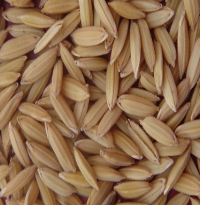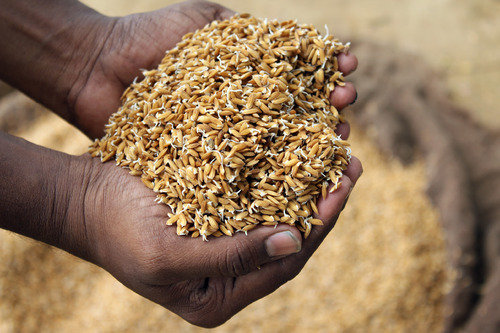SEED
Selection of seed : Seed selection plays an important role in paddy cultivation. The seeds selected for cultivation should be of uniform size, age and free of contaminants. They should also have good germination capacity.
Separation of quality seed : To separate good seed from bad, soak them in water: the unviable seeds will float on the surface of water. These seeds can be easily emoved and the seeds that sink can be used for cultivation. By this method, damaged seeds are easily removed. Another method is used when there is an excess of chaffy grain in the seed stock. Take some water in a vessel and drop an egg in it. Keep adding salt slowly till the egg reaches the surface. When the seeds are dropped into the water, the good quality seeds will sink. Remove the unviable seeds that float on the surface of the water. Wash the selected seeds in good water 2–3 times to remove the salt deposits. If this is not done, the germination capacity of the seeds will be affected. |
 |
Seed rate : The seed rate varies according to the variety to be cultivated. The seed rate required for one hectare of land under irrigated condition is given below:
| Short duration variety |
: |
60-70 Kg |
| Medium duration variety |
: |
40-60 Kg |
| Long duration variety |
: |
30-60 Kg |
| Dry and rain fed sowing |
: |
85 - 100 Kg |
Germination test : The germination test is considered the most important quality test for evaluating the planting value of a seed lot. The test is designed to measure the ability of seeds to produce normal seedlings and plants later on. The various ways of performing a germination test are listed below:
- Tie a handful of seeds in a white cloth, soak it in water for 12 hours and keep in a dark place for 24 hours.
Check the germination percentage the next day.
- Tie paddy straw together to make it into a mat. Keep the seeds in the centre of the mat and then roll and tie it.
Dip it in water for a minute and transfer the seeds to straw. After 24 hours, count the seeds that have germinated.
- Take a wet gunny bag, fold it, put the seeds in between the two layers and keep the bag in the dark for a day.
Check the germination the next day.
|
 |
Treatment
Seed treatment helps to improve germination potential, vigour, and resistance to pests and disease. The different methods of rice seed treatment are:
- Soaking the seeds in water :
Tie the seeds in a small gunny bag or cloth bag and soak it in water for 12 hours. Later, remove the bag from the water and cover it with a moist gunny bag. The following day, soak the seeds in water for eight hours again. Later, remove the seeds from the water and sow them in the nursery. This method helps to improve the germination capacity of the seeds.
- Using cow dung solution : Treating paddy seeds in a cow dung solution enhances their germination. Take 1⁄2 kg of fresh cow dung and two litres of cow urine and dilute them with five litres of water. Soak 10–15 kg seeds first in water for 10–12 hours and then in the cow dung solution for 5–6 hours. Dry the seeds in the shade before sowing them in the nursery.
- Using goat dung solution :
Treating 30-day old seeds for one day in a goat dung solution increases their germination. Using cow's urine solution Dilute 500 ml of cow's urine in 2.5 litres of water. Tie the seeds in small bags and soak them in the urine solution for half an hour. Dry the seeds in the shade before sowing them.
- Using sweet flag extract :
Dissolve 1.25 kg of sweet flag rhizome powder in six litres of water. Tie the seeds in small bags and soak them in the extract for half an hour. Dry the seeds in the shade before sowing. (This is the quantity required for treating seeds to be sown in one hectare.) Using Salvadora persica Spread the leaves of Salvadora persica at the bottom of a closely- knit bamboo basket, then fill it with seed and pour about 10 to 12 litres of water over the basket. Cover the basket with the Salvadora leaves and place a weight over it. Leave the seeds undisturbed for 24 hours. The seeds are then ready to be used for sowing in the nursery. This procedure helps in early and vigorous germination. Treatment of rice seed with amrut pani/panchagavya/cow pat pit manure/jeevamrut is also effective. The efficiency needs to be evaluated.
- Using biofertilisers :
Biofertilisers like azospirillum/azotobacter/pseudomonas (@ 1.25 kg/ha) are first mixed in one litre of cooled rice gruel. Spread the sprouted seeds on a clean floor, add the biofertiliser slurry and mix well. The mixing of seed and biofertiliser slurry can be done in a pot as well. Dry the seeds in the shade for 30 minutes before sowing. Drying the seeds for half an hour in the bright sun before sowing improves germination and seedling vigour.
Source : Centre for Indian Knowledge Systems, Chennai
Updated on : Dec 2014 |


